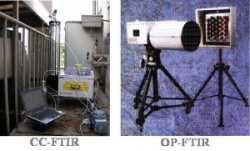Dec 29 2009
Due to land scarcity and dense population, coupled with the sustained economic growth, industrial zones in Taiwan are generally close to residential areas. In addition to perceptible evil odor from pollution, the human health hazards associated with industrial emissions are likely to emerge only after many years.
 FTIR works on the principle that a particular functional group or bond of compounds in vibration or rotation will uniquely absorb infrared light of particular frequency
FTIR works on the principle that a particular functional group or bond of compounds in vibration or rotation will uniquely absorb infrared light of particular frequency
Shieh Yan–Ru, the Air Protection Department director of Environmental Protection Administration (EPA), Executive Yuan indicated in a recent interview that full implementation of the health risk assessment of air pollutants will help early detection of problems in order to protect public safety.
He said that under normal circumstances, the level of pollution in the industrial zones largely comply with the regulations concerning environment and labor safety; but to further ensure the good health of workers and residents surrounding the zones, we cannot rely solely on the relevant provisions, but should monitor the correlation between air pollutants and human health for long term, so as to assess whether there would be potential health hazards coming from the zone’s pollution and whether to issue early warning.
Shieh pointed out that the U.S. Environmental Protection Agency 1999 proclaimed Fourier Transform Infrared (FTIR) remote sensing technology as standard motoring methods, Taiwan’s EPA also proclaim Extractive FTIR as gas compound detection methods (NIEA A001.10C) and Open–Path FTIR as volatile compound screening method (NIEA A002.10C) in 2003 and 2005 respectively, with a view to expanding the horizons of environmental protection and pollution control work.
FTIR works on the principle that a particular functional group or bond of compounds in vibration or rotation will uniquely absorb infrared light of particular frequency, which is determined only by the compound structure and bond location and independent of other factors, and then identify the exact type of pollution compounds through calculating by theory or checking with spectral database.
To track down unknown source of pollution in petrochemical industrial parks, the EPA started 1998 employing FTIR-capable of measuring a variety of compounds simultaneously, to conduct environmental and plant process monitoring. Up to August 25, 2009, the EPA had conducted 83 supervisions of petrochemical plants in Dashe, Linyuan, Kaohsiung-Pingtung and the Sixth Naphtha Cracker Plant.
Shieh said that because of combining various functions including continual real-time monitoring 'no need of sampling procedures' simultaneously measuring a variety of compounds 'broad detection range' automatic detection and long-time archive keeping, and its measured data can provide pollution prevention-related information, FTIR is expected to gradually replace the existing gas monitoring system in industrial zones for air quality monitoring and gas leaks alert.